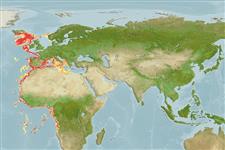Preferred temperature (Ref.
123201): 4.5 - 13.5, mean 8.5 °C (based on 237 cells).
Phylogenetic diversity index (Ref.
82804): PD
50 = 0.5000 [Uniqueness, from 0.5 = low to 2.0 = high].
Bayesian length-weight: a=0.00316 (0.00189 - 0.00529), b=3.17 (3.02 - 3.32), in cm total length, based on LWR estimates for this species & (Sub)family-body (Ref.
93245).
Trophic level (Ref.
69278): 3.7 ±0.2 se; based on diet studies.
Generation time: 13.7 ( na - na) years. Estimated as median ln(3)/K based on 2
growth studies.
Widerstandsfähigkeit (Ref.
120179): sehr niedrig, Verdopplung der Population dauert mehr als 14 Jahre. (Preliminary K or Fecundity.).
Fishing Vulnerability (Ref.
59153): High vulnerability (60 of 100).
Climate Vulnerability (Ref.
125649): Low vulnerability (12 of 100).
Nutrients (Ref.
124155): Calcium = 20.6 [11.0, 59.7] mg/100g; Iron = 0.387 [0.145, 1.009] mg/100g; Protein = 11.5 [9.6, 14.7] %; Omega3 = 0.41 [0.16, 1.12] g/100g; Selenium = 26.1 [10.0, 66.7] μg/100g; VitaminA = 12.7 [2.6, 62.0] μg/100g; Zinc = 0.436 [0.272, 0.726] mg/100g (wet weight);
